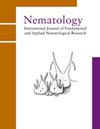Steinernema yirgalemense (Steinernematidae) to control Phlyctinus callosus and Phlyctinus xerophilus (Curculionidae)
IF 1.1
4区 生物学
Q2 ZOOLOGY
引用次数: 0
Abstract
Considerable progress has been made in the surveying, taxonomy, screening, mass production and formulation of entomopathogenic nematodes (EPN) and their associated symbiotic bacteria in South Africa. Steinernema yirgalemense isolate 157-C is one of the most promising native EPN candidates with regards to virulence, its broad insect-host spectrum, and can be readily mass-produced and formulated into a commercial product. The banded fruit weevils, Phlyctinus callosus sensu stricto and Phlyctinus xerophilus, previously grouped together under the Phlyctinus callosus sensu lato species concept, are native entimine weevils of economic importance to deciduous fruit, grapevine and berries in the Western Cape province of South Africa. This study investigated potential differences in baseline susceptibility of larvae and pupae of the two weevil species to S. yirgalemense in laboratory screenings. The test arena used was 24-well bioassay plates, with an inoculation concentration of 200 infective juveniles (IJ) insect−1 for larvae and 100 IJ insect−1 for pupae. Infection was determined 48 h and 96 h after inoculation. Field-efficacy of S. yirgalemense, applied at a concentration of 60 IJ cm−2, against larvae of the two weevil species was determined in an ecologically relevant semi-field trial. In all cases in vitro mass-produced IJ of S. yirgalemense were used. No baseline differential susceptibility between P. callosus and P. xerophilus larvae was obtained in laboratory screenings. Phlyctinus pupae were approximately twice as susceptible compared to larvae, with significant differences between bioassay batches. Approximately 45% control of P. xerophilus larvae was obtained after 96 h of exposure to S. yirgalemense in the field, differing significantly from the control and P. callosus treatment. Low levels of Phlyctinus larval infection by native EPN (confirmed as Heterorhabditis bacteriophora from one P. xerophilus cadaver) occurred in both control and EPN treatment groups under field conditions.用 Steinernemema yirgalemense(Steinernematidae)来控制 Phlyctinus callosus 和 Phlyctinus xerophilus(Curculionidae)。
南非在昆虫病原线虫(EPN)及其相关共生细菌的调查、分类、筛选、大规模生产和配制方面取得了长足的进步。Steinernema yirgalemense 分离物 157-C 是最有前途的本地 EPN 候选者之一,它具有毒性强、昆虫寄主范围广等特点,而且可以很容易地大规模生产并配制成商业产品。带果象鼻虫(Phlyctinus callosus sensu stricto和Phlyctinus xerophilus)以前被归入Phlyctinus callosus sensu lato物种概念下,是对南非西开普省落叶水果、葡萄藤和浆果具有重要经济价值的本地象鼻虫。本研究调查了两种象鼻虫的幼虫和蛹在实验室筛选中对 S. yirgalemense 的基线敏感性的潜在差异。使用的试验场是 24 孔生物测定板,幼虫的接种浓度为 200 感染幼虫 (IJ) 昆虫-1,蛹的接种浓度为 100 感染幼虫 (IJ) 昆虫-1。接种后 48 小时和 96 小时测定感染情况。在与生态相关的半田间试验中,确定了施用浓度为 60 IJ cm-2 的 S. yirgalemense 对两种象鼻虫幼虫的田间药效。在所有情况下,都使用了体外大规模生产的 S. yirgalemense IJ。在实验室筛选中,没有发现 P. callosus 和 P. xerophilus 幼虫之间的基本敏感性差异。与幼虫相比,Phlyctinus 蛹的易感性约为幼虫的两倍,生物测定批次之间存在显著差异。在田间暴露于 S. yirgalemense 96 小时后,P. xerophilus 幼虫的控制率约为 45%,与对照组和 P. callosus 处理有显著差异。在田间条件下,对照组和 EPN 处理组的 Phlyctinus 幼虫都受到了本地 EPN(从一具 P. xerophilus 尸体中确认为细菌异型线虫)的低水平感染。
本文章由计算机程序翻译,如有差异,请以英文原文为准。
求助全文
约1分钟内获得全文
求助全文
来源期刊

Nematology
生物-动物学
CiteScore
2.60
自引率
33.30%
发文量
67
审稿时长
3 months
期刊介绍:
Nematology is an international journal for the publication of all aspects of nematological research (with the exception of vertebrate parasitology), from molecular biology to field studies. Papers on nematode parasites of arthropods, and on soil free-living nematodes, and on interactions of these and other organisms, are particularly welcome. Research on fresh water and marine nematodes is also considered when the observations are of more general interest.
Nematology publishes full research papers, short communications, Forum articles (which permit an author to express a view on current or fundamental subjects), perspectives on nematology, and reviews of books and other media.
 求助内容:
求助内容: 应助结果提醒方式:
应助结果提醒方式:


